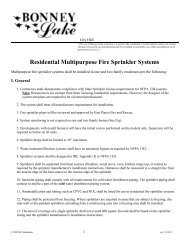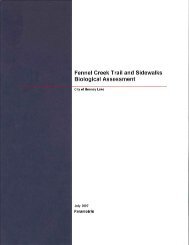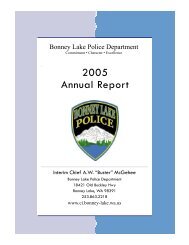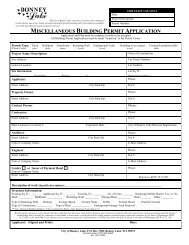Part 1 - City of Bonney Lake
Part 1 - City of Bonney Lake
Part 1 - City of Bonney Lake
You also want an ePaper? Increase the reach of your titles
YUMPU automatically turns print PDFs into web optimized ePapers that Google loves.
Water System Description<br />
In 1995, the <strong>City</strong> utilized Victor Falls Springs as its major source. Over 56 percent <strong>of</strong> the <strong>City</strong>’s<br />
total annual production was from this source, or approximately 1,424 acre-feet (1.27 MGD).<br />
This was primarily due to the high water quality <strong>of</strong> this source and to its proximity to the<br />
system’s high demand areas. Over the last twelve years substantial growth has occurred in the<br />
north end <strong>of</strong> the system and the <strong>City</strong> has relied on the Tacoma Point wellfield more <strong>of</strong>ten<br />
throughout the year. Therefore, in 2006 the <strong>City</strong> no longer utilized Victor Falls Springs as its<br />
major source and used only 1,151 acre-feet (1.03 MGD) from this source, or 29 percent <strong>of</strong> its<br />
total production.<br />
Grainger Springs<br />
The Grainger Springs’ facilities are located southwest <strong>of</strong><br />
the summit <strong>of</strong> State Route 410 (18100 SR410). Flow<br />
from this source varies between 650 gpm and 1,300 gpm<br />
(0.94 MGD and 1.87 MGD). Like Victor Falls Springs,<br />
the minimum flow <strong>of</strong> this source occurred in 1985. The<br />
average low flow in the summer months for 1998 through<br />
2006 was 880 gpm (1.27 MGD).<br />
Grainger Springs Treatment Facility<br />
Grainger Springs’ water is collected at perforated pipe<br />
and manholes along the toe <strong>of</strong> the hill and flows by gravity through pipes to the Grainger Springs<br />
pump station’s wet well. The water is pumped into the distribution system by one 75-<br />
horsepower pump and one 150-horsepower pump with capacities <strong>of</strong> 500 gpm and 1,000 gpm<br />
(0.72 MGD and 1.44 MGD), respectively, and are <strong>of</strong> the same design<br />
as the pumps at Victor Falls Springs. These pumps are also controlled<br />
by the water tank levels <strong>of</strong> the Ponderosa and Tacoma Point water<br />
tanks, as recorded by the telemetry systems. This pump station<br />
includes complete chlorination facilities, which are located in a<br />
separate structure, and a 150 kW emergency power generator. In<br />
2003, chlorine contact time improvements were made to achieve a CT<br />
<strong>of</strong> 6 at this source. In 2005, the gas chlorination system was replaced<br />
with an on-site sodium hypochlorite generation system and pH<br />
adjustment for corrosion control.<br />
As in 1995, the <strong>City</strong> still utilizes Grainger Springs as its second largest<br />
source with 24 percent <strong>of</strong> its annual production from this source. This<br />
is still the case in 2006, although total production capacity has grown<br />
from 602 acre-feet (0.54 MGD) in 1995 to 941 acre-feet (0.84 MGD) Grainger Springs Pump<br />
in 2006, as the water system has grown. Grainger Springs is sill<br />
utilized as much as possible by the <strong>City</strong> due to the high water quality <strong>of</strong> this source and to its<br />
centralized location in the <strong>City</strong>’s system.<br />
CITY OF BONNEY LAKE COMPREHENSIVE WATER SYSTEM PLAN 2-9 J:\DATA\BON\507-036\PLAN\WCPCHAPTER2.DOC









